-
oa Editorial [Hot Topic: Novel Targets for Anti-Viral Treatments (Guest Editor: Sabine C. Piller)]
- Source: Current Drug Targets, Volume 7, Issue 12, Dec 2006, p. 1561 - 1561
-
- 01 Dec 2006
Abstract
This special edition of Current Drug Targets entitled “Novel targets for anti-viral treatments” was inspired by the recent advances in the HIV field. Despite intense research over more than two decades there are still several unresolved questions regarding the detailed molecular mechanism of several of the HIV proteins, their interaction with cellular proteins and the effect of such interactions. With the emergence of drug resistant and recombinant HIV strains, a renewed interest in elucidating basic molecular mechanisms of viral protein interactions with the host cells was sparked. The difficulties encountered with the development of a successful vaccine further encouraged basic research into a better understanding of the viral-host interactions in the hope of identifying novel drug targets. Recent advances in technology including the development of siRNA technology, microarray technology and increased use of advanced laser scanning confocal microscopy techniques to visualize fluorescently labelled proteins have all substantially contributed to a better understanding of many viral replication steps and hence the identification of novel drug targets, some of which may be relevant to viruses other than HIV. In this edition seven examples of the latest exciting advances of exploring novel antiviral drug targets are covered. Firstly, insights into the biology of dendritic cells and their unique role for virus dissemination to the draining lymph nodes are discussed. Development of microbicides that are capable of preventing transmission of virus at mucosal sites particularly during sexual transmission of HIV, which is greatly on the increase in developing countries, will need to include protection of dendritic cells. The discovery of C-type lectin receptors and their unique distribution on various subsets of dendritic cells may prove an exciting new target for the development of microbicides and several novel strategies are discussed by Wilkinson and Cunningham. This is followed by a discussion on the potential use of IL-7 in HIV as wells as cancer treatment. With IL-7 being currently used as adjuvant therapy in phase I/II clinical trials, the review by Sasson et al. highlights the importance of a detailed understanding of the IL-7/IL-7 receptor system in order to develop safe new therapeutics that are able to manipulate the signalling through this system resulting in beneficial outcomes not only for HIV treatment but in a number of lymphopenic conditions. Identifying cellular interactions of viral proteins has vastly increased our understanding of cellular processes and opened new potential targets for antiviral therapy which is nicely exemplified by the contributions of Carr et al. and Harrich et al. on the interaction of the HIV protein Vif with the cellular protein APOBEC3G and the interactions of the HIV protein Tat with cellular proteins such as protein kinase R, p300/CBP, P/CAF, cyclin T1, and RNA polymerase II, respectively. In addition, both Vif and Tat also interact with other HIV proteins and are involved in protease activity, virus packaging and reverse transcription, respectively. A better understanding of these and other steps of viral replication and the involvement of each and every viral protein will be essential for the future development of specifically targeted anti-HIV drugs. Another potential drug target is the genetic material of HIV, RNA itself or RNA intermediates as discussed in Fannings' review which gives an exciting insight into the co-evolution of cellular responses to signature viral RNA intermediates and the counter measures employed by viruses. Fanning further explores the potential use of the latest technologies such as RNAi and siRNA in the treatment of HIV. Advances in the lipid biology field with the discovery of specialised membrane areas, the lipid rafts, which are cholesterol rich and non-ionic detergent resistant, have also been taken into consideration for potential drug development against a variety of pathogens that rely on the presence of lipid rafts for their entry and replication as reviewed by Hawkes and Mak. Reagents that can interfere with lipid rafts may turn out to become a great addition to topical microbicide development. Last but by no means least, Rawlinson et al. review the biology of the flavivirus that causes dengue fever and dengue hemorrhagic fever which is the most common arthropod-borne viral infection. In particular, one of its non-structural proteins, NS5 is identified as an ideal drug target candidate due to its important role in two essential processes of dengue replication. These reviews are by no means the only areas of intense research but are just some examples of the exciting field devoted to discovering potential anti-viral targets. The articles in this special issue have all highlighted the importance of a better, more detailed understanding of each step of virus replication at a molecular level in order to be able to develop novel drugs in the combat of new and emerging viral diseases. I am looking forward to the results of the next 20 years in this exciting and expanding area of research.


